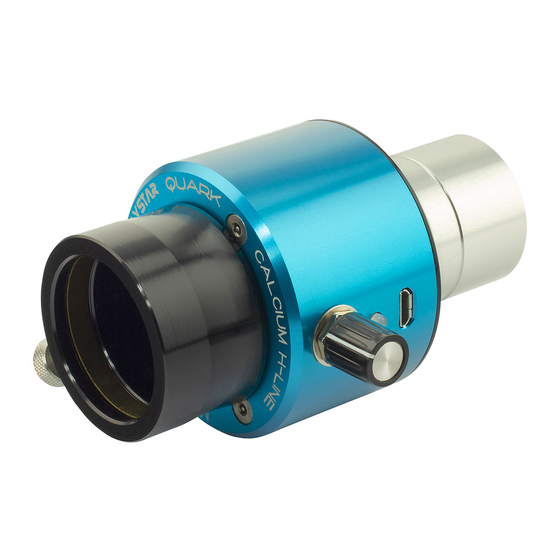- ページ 4
アクセサリー DayStar Filters CALCIUM QUARKのPDF マニュアルをオンラインで閲覧またはダウンロードできます。DayStar Filters CALCIUM QUARK 17 ページ。

Additional tuning can be performed, just keep in mind that after every
adjustment of the knob the filter must settle in temperature for
approximately 5-10 minutes before your change becomes effective.
Tuning can also be used to observe Doppler shifted features moving
towards or away from you. A feature moving towards you will be brighter
in blue (counterclockwise) wing shift, away from you will be reddened
(clockwise knob tuning).
ENERGY REJECTION:
Energy Rejection Filters reduce the heat load on your filter assembly by
absorbing or reflecting UV and/or IR light and transmitting light in the
visual spectrum.
Note that Red and Yellow glass ERFs are NOT compatible with the
Calcium Quark as they do not pass the Calcium wavelength, by the
nature of colored glass.
Please note, a Herschel Wedge or white light filter cannot be used with
the Quark. Those filters block 99.999% of all light, including the desired
Calcium H light.
REFRACTORS:
For brief observing sessions using refractors with less than 80mm of
aperture when not using a tracking mount, no rejection is necessary. Be
alert for any rise in temperature of your telescope, diagonal, or Quark.
For telescopes under approximately 150mm of
aperture, a screw in UV/IR cut filter can be
employed in front of the telescope diagonal.
The UV/IR cut filter reflects UV and IR light
back out the front of the telescope, reducing
temperatures inside. Do not use a UV/IR cut
filter with a telescope with an integrated rear
field flattener or Petzval lens. The UV/IR cut filter must be the first optical
element to encounter concentrated light. Note that Calcium falls outside
the passband of some UV/IR cut filter designs, so always verify that a
prospective UV/IR filter passes 397nm before purchasing.
